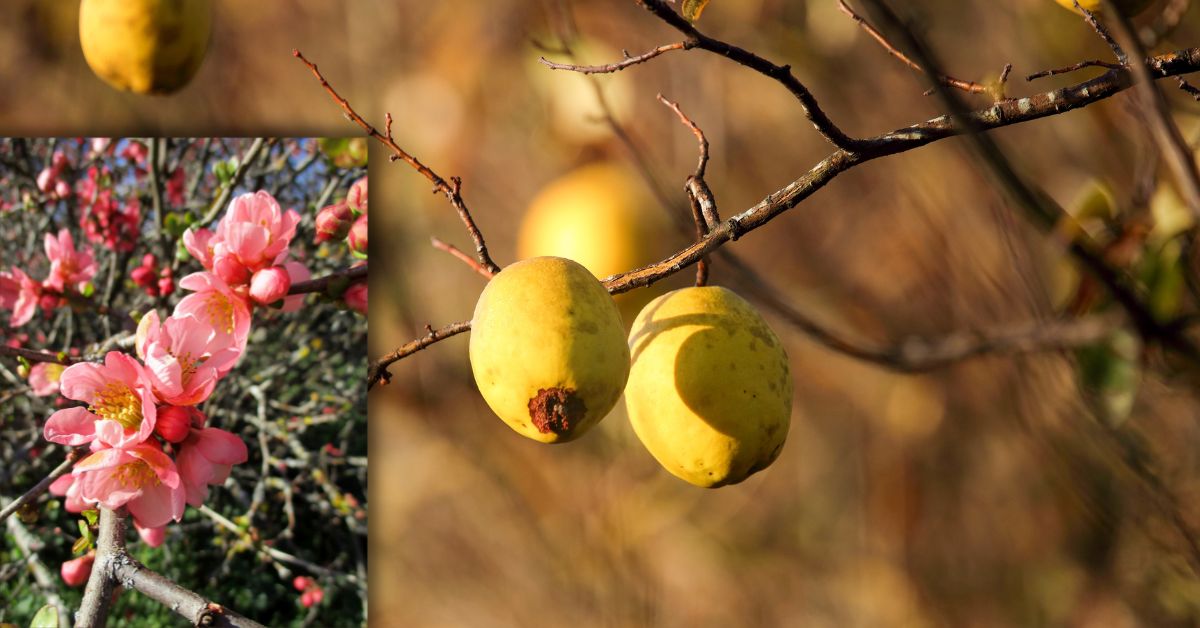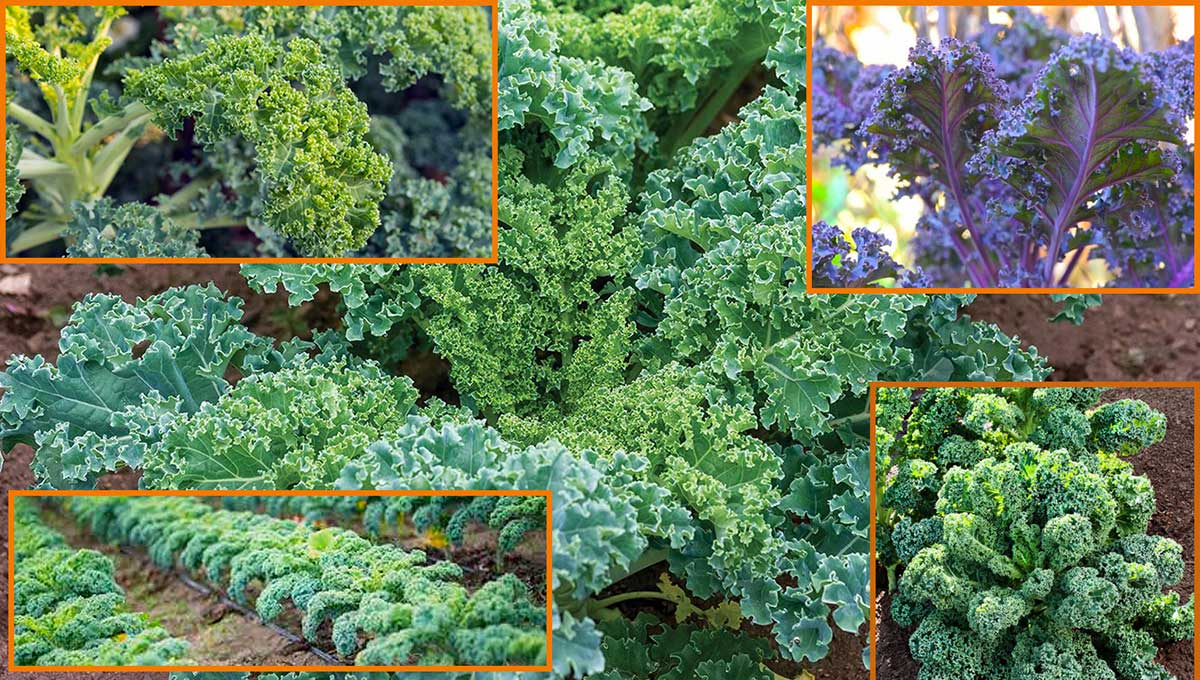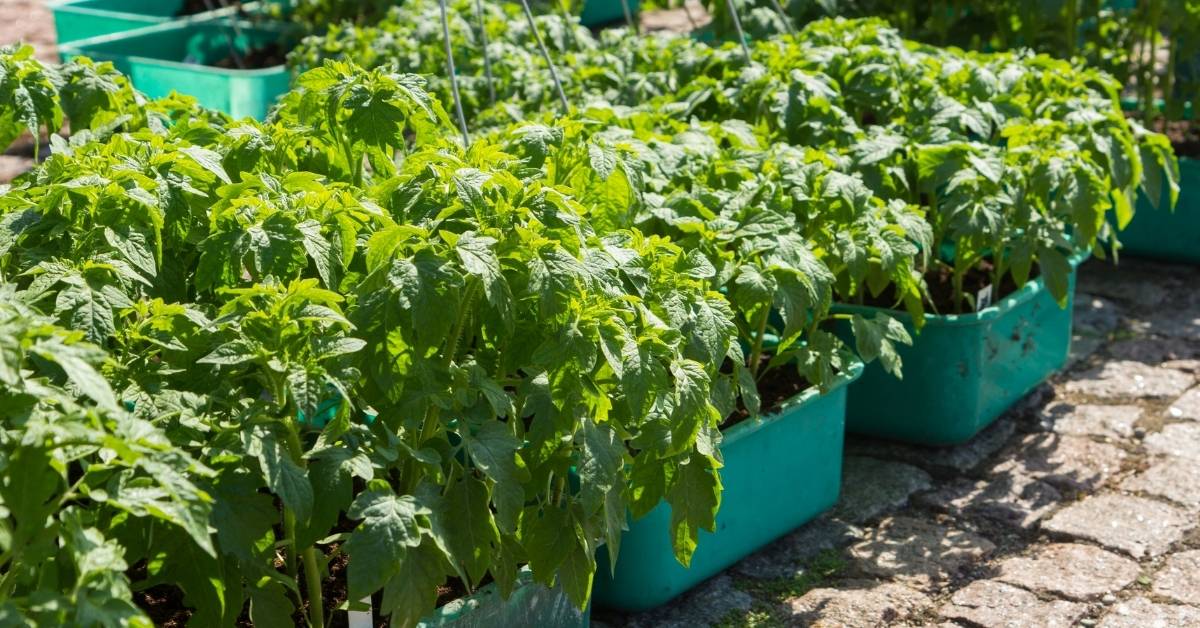Like all trees with interesting bark, the Chinese Quince demands to be touched. The darker outer layer is shed with mysterious tidiness: There’s no obvious flaking or mess.
Plus, the bark covers a rippling trunk unique in hardy trees: It’s completely ringed with rounded, narrow, vertical waves—called flutes—and looks like a column sheathed with floor-length drapery in a stylish, environmentally-cool pattern.
And then there are the fruits. Bright yellow, fragrant, hard, and heavy fall to the ground with a bounce. Compared to the suave trunk, they seem like comic relief.
Yes, there are also flowers (pink in Spring), as well as handsome foliage (with good Fall coloring). But with bark to rival the best of any stewartia or lacebark pine, plus the unique fluted trunk, Pseudocydonia Sinensis is a tree to grow, first, for its ground-level performance, and only second for what happens higher up in the canopy.
Chinese Quince (Pseudocydonia Sinensis)
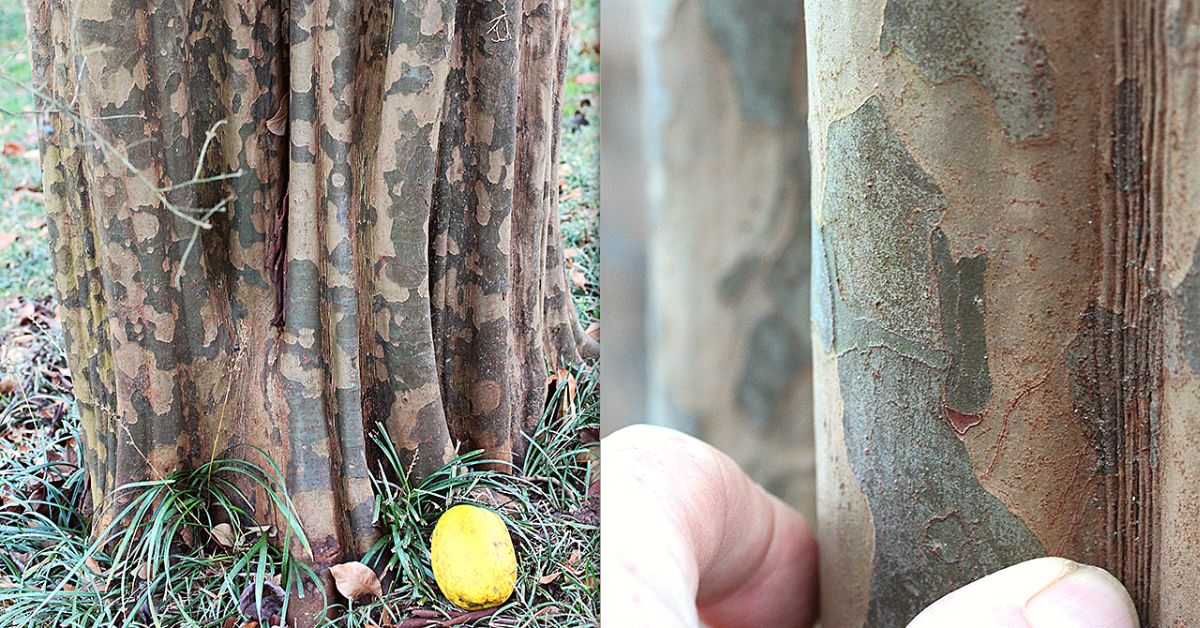
The Chinese Quince, also known as Pseudocydonia Sinensis, is a thick, rounded, big shrub or small tree that typically grows between 10 and 20 feet in height but has the potential to reach a height of 40 feet. In most cases, the width is equal to two-thirds of the height. The exfoliating bark is a lovely characteristic, as it peels off in uneven places, revealing a mosaic of gray, green, and brown below.
It has dark green foliage in the summer, which transforms into beautiful yellows and reds in the Fall. It has an early leafing out. Midway through the Spring, single blooms of a pale pink hue measuring between 1 and 1.5 inches across appear.
It gives rise to quince fruit that is golden in color, fragrant, between 5 and 7 inches in length, and is excellent for making jams and jellies. The shrub does best when grown in full sun and on soil that is acidic, wet, and well-drained. This plant is susceptible to being destroyed by fireblight. An outstanding shrub with nice bark, gorgeous blooms, and appealing fruit in the autumn.
Originating in China, they arrived about 1800.
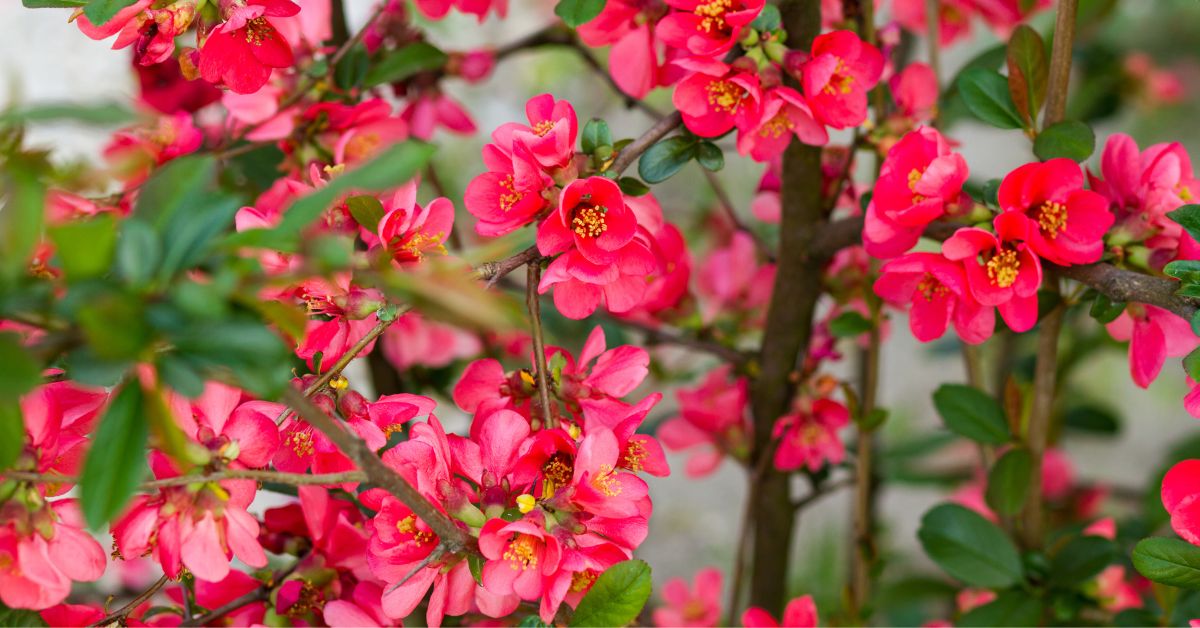
Here’s how to grow this singular species, which is exceptional and exciting year-round:
| Latin Name | Pseudocydonia Sinensis |
| Common Name | Chinese Quince |
| Family | Rosaceae, the Rose family. |
| What kind of plant is it? | Pseudocydonia can function as a very large shrub or, when limbed up, as a small ornamental tree. |
| Hardiness | Zones 5 – 7 |
| Habit | Densely branching, upright, and multi-stemmed. |
| Rate of Growth | Slow to medium. |
| Size in ten years | Eight to twelve feet. Ultimately, ten to twenty feet tall, somewhat less than that wide. Occasionally much taller, even to forty feet. |
| Texture | The canopy can be dense; if lower branches don’t die off naturally, it’s better to remove them so as to expose the showy bark and fluted trunks. This pruning, in turn, can also reduce overall foliage density. See both “How to handle it” boxes below. |
| Native habitat | Pseudocydonia Sinensis is, indeed, native to China. |
| Where to buy Chinese Quince? | Online and, rarely, at “destination” nurseries. Between September and November, you will also have the greatest opportunity to locate a perfect quince on the market or in organic food shops. As a result of the quince’s sensitivity to shock, the fruit frequently develops brown spots when it is being harvested. |
Why should you grow Chinese Quince Plant?
To benefit from its fruit
Startling deep-yellow oval fruits are five to seven inches long and can weigh nearly two pounds. They ripen from late Summer into Fall and can remain on the branches well into Fall, even after foliage drop.
Given their color, size, and firmness, the fruits are equally impressive when they’ve fallen to the ground: They don’t split or dent but, rather, rest atop the ground mysteriously.
To visitors unfamiliar with the species, the fallen fruits look like a shipment of Florida citrus unaccountably spread out under a northern tree. Or that the family dog has a few dozen chew toys.
The flavor is astringent in the extreme; the fruit is incorporated into jams and chutneys, where its large amount of pectin helps jelling, and the recipe’s generous amount of sugar mitigates its sourness.
For its flowers
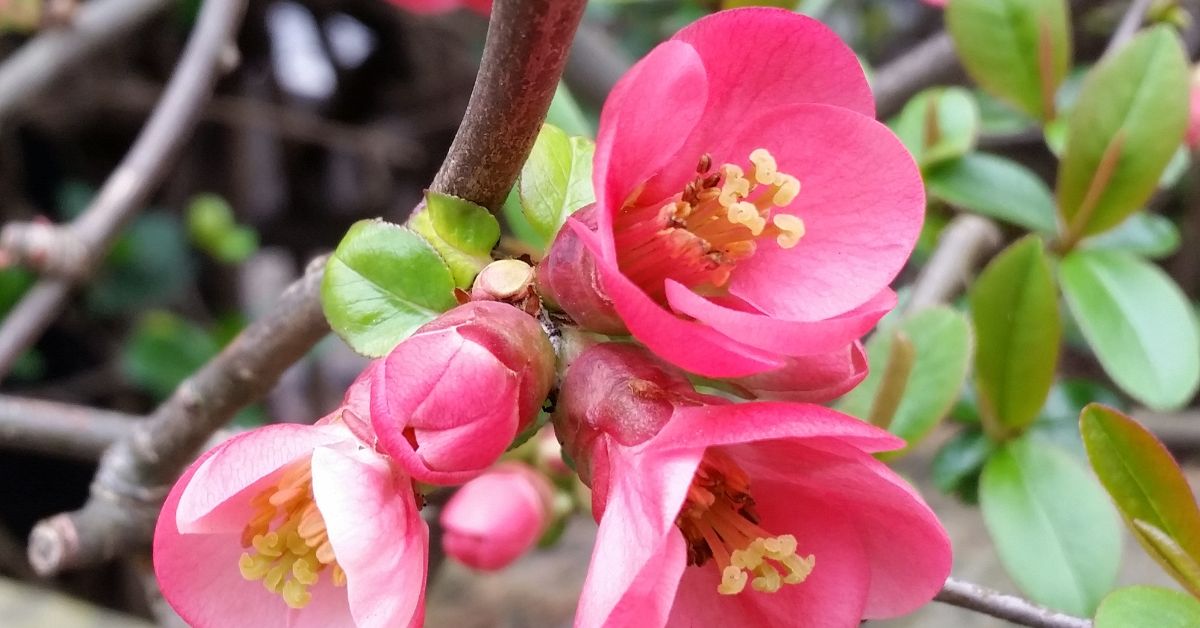
Just over an inch across, they are charming but not impressive. Hues vary from pale to deep pink. They’re fragrant, too.
For its bark
The khaki-brown bark of older stems exfoliates smoothly to reveal inner layers in lighter shades of tan and cinnamon. The pattern’s intensity is equal to that of Stewartia and Pinus bungeana. As is typical for exfoliating Chinese Quince bark, the show is best on thicker (and, therefore, older) stems—and, so, is best of all on the trunks.
The wider the trunk, the greater the number of trunks, and the better access you have to inspect the tree closely, the bigger, better, and more exciting the show. Therefore, like beeches, plane trees, and sequoias, Pseudocydonia Sinensis is a tree to have planted decades ago—or, failing that, as soon as possible.
Those trees’ exceptional overall size makes their performance impressive at a distance: They are just as thrilling at the far end of a vista as when viewed right at hand. Pseudocydonia lacks its size and monumentality, so its most memorable appreciation will always be when it’s sited in intimate settings.
See “Where to use it,” “Plant partners,” and both “How to handle it” boxes for suggestions on siting, growing, and “contexting” this species to maximize its appeal.
For its fluted trunks
I’m not aware of another tree hardy to Zone 5 whose mature trunks develop this species’ extensive vertical, rounded, rippling extensions. Some trees are tolerant of soil moisture, such as bald cypress and hemlock, flute at their flaring base, in which case the fluting is known as buttressing. And the trunks of native hornbeams, Carpinus carolinianus, can develop a striking multi-directional rippling overall that, fittingly, leads to one of the species’ common names: muscle wood.
But the fluting of Pseudocydonia is unique in extending with tidy vertical order up the entire trunk, not just the base. Further, there’s little basal flaring, increasing the trunks’ resemblance to columns of floor-length drapery. The same intimate spaces and full accessibility that maximize the display of the bark also ensure that your experience of the fluting is as powerful as possible.
Its Fall foliage, which can be yellow to pink to red.
Flowering season
As the leaves emerge. Depending on the arrival of Spring where you garden, this could be any time from late March into May.
Color Combinations
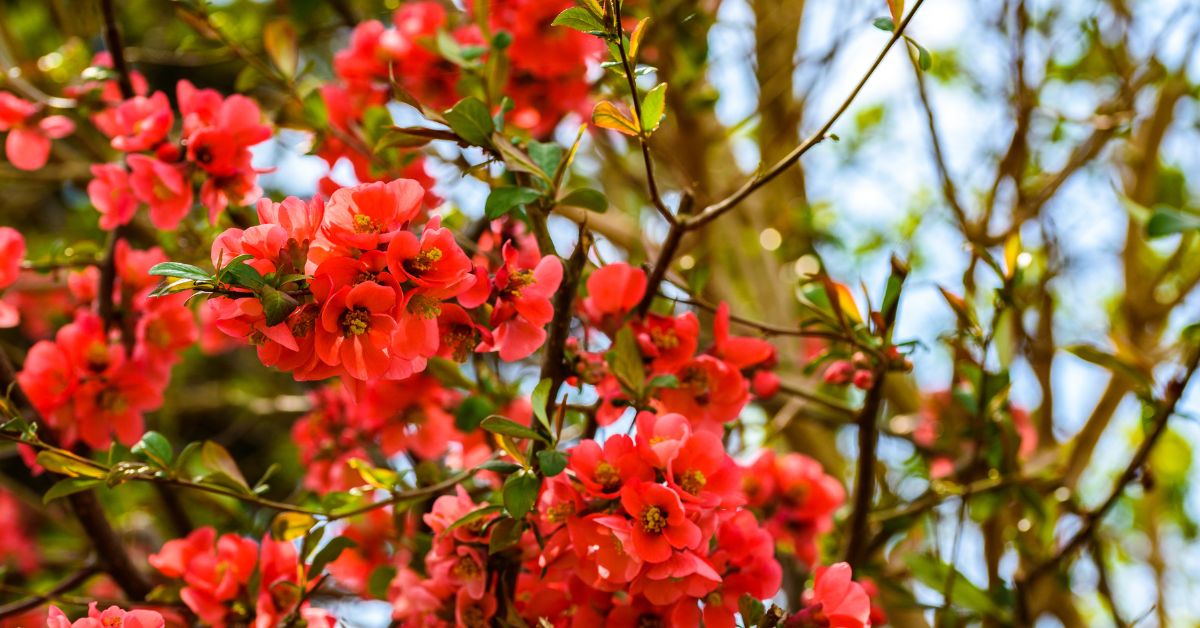
The colors of the tree’s year-round show of bark—tans, browns, and greens—can combine with anything. The pink flowers in Spring, the yellow-to-red foliage, and the deep yellow fruit in Fall, have much more limited versatility.
Worse, their preferred color partners are almost all incompatible: The pink flowers call out for the “cools” of pink, blue, or purple, whereas the bright Fall foliage and fruits call out for the “hots” of yellow, orange, and red. Burgundy and white would be the only two colors that would work season-long.
Thank goodness both seasonal shows are ephemeral. You can surround the tree with some partners that sing the glories of a pink-friendly palette in Spring and others that celebrate yellow-to-red in the Fall. Some plants, of course, are seasonal multi-taskers and can handle both shows. For example, the Spring flowers of Cercis canadensis are usually pink, whereas its Fall foliage is yellow.
Yet another possibility is to grow a pair of widely-separated Pseudo- Cydonia. One can be surrounded by “Spring Pink Or Bust!” plants (and who cares about Fall), and the other by “Hot Fall Colors Forever!” plants (and who cares about Spring.)
An even better strategy is to say “Thanks, but no thanks” to establish color linkages from the flowers, Fall foliage, and yellow fruits outward to your garden. The yellow of the fruits and Fall foliage doesn’t harmonize with the muted hues of the bark, anyway, and neither does the pink of the flowers.
Instead, provide surrounding horticulture that is unfailing “on” and supportive of the species’ superlative year-round display of bark, especially during the winter. Then this unique tree will always have the respectful staging it needs. See “Plant partners” and “Where to use it” below.
Plant partners
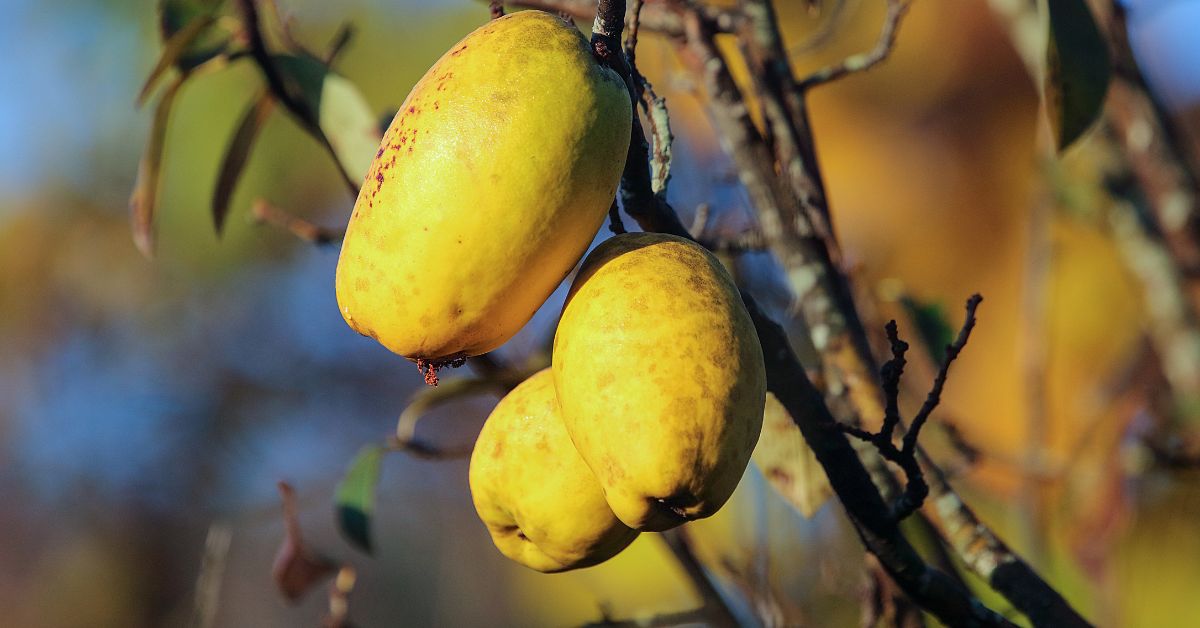
No matter what taller plants you choose as part of the tree’s bark and side tableaux, for the front, choose a plant that’s short, dense, and tolerant of shade as well as foot traffic. Moss would be best, but it needs to choose you. (Help it make up its mind by providing moisture-retentive soil at the front of the Quince, with taller plants strategically sited nearby to block the sun.)
If you’re gardening in Zone 7, plant dwarf mondo grass (Ophiopogon japonica ‘Nana’). Black mondo (Ophiopogon planiscapus ‘Nigrescens) is hardier in Zone 6 and tolerates more sun; its dark purple foliage is a sophisticated contrast to the tree’s bark. Pennsylvania sedge (Carex pensylvanica) has green foliage, and it’s hardy to Zone 3.
Given the trunk’s year-round appeal, choose plants whose coloring coordinates with its tan/cinnamon/khaki palette, especially in cool summer. Apricot is one additional color to focus on; see the “Plant partners” box of the orange-twigged linden article. Or cinnamon: Is there enough moisture nearby for cinnamon fern? The woody brown fertile fronds of Osmundastrum cinnamomeum would match patches of the quince bark.
Dark green is always effective, especially when it’s evergreen. Prostrate plum yew (Cephalotaxus harringtonia ‘Prostrata’) would be dramatic lapping at the back and sides of the trunk. I’ll site my Pseudocydonia in front of a hedge of American holly (Ilex opaca). If you have the same opportunity, choose the holly’s yellow-berried form so you can emphasize the yellow of the quince fruits.
Where to use it in your garden
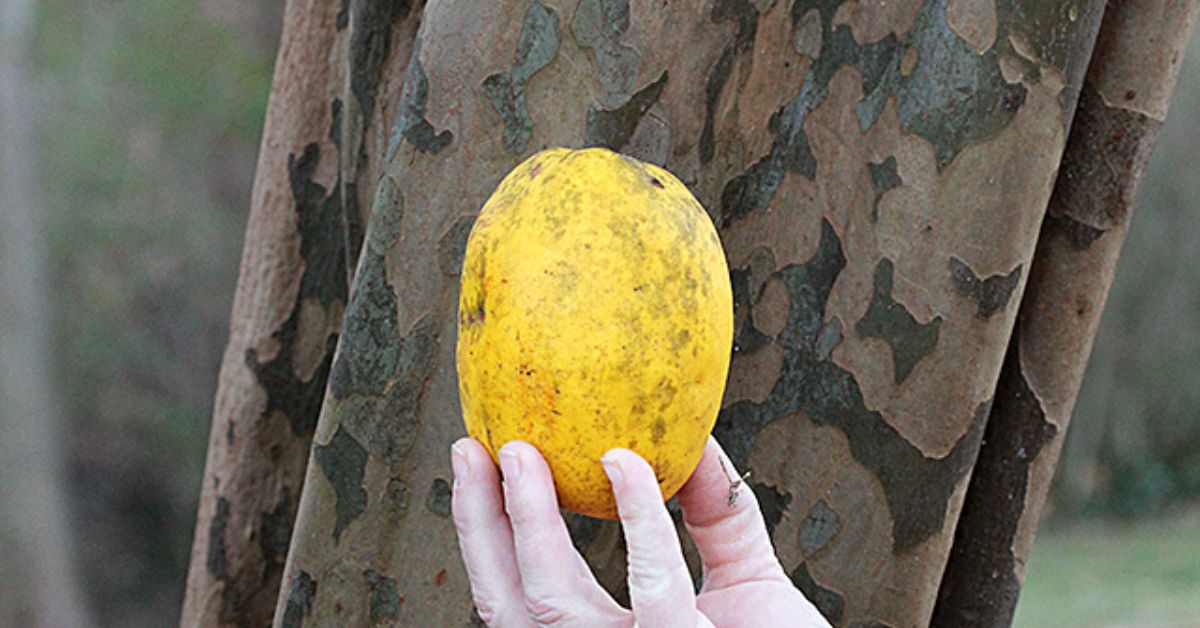
The stunning pattern of the exfoliating bark combines with the uniquely orderly and extensive vertical fluting of the trunk to make a mature Pseudocydonia a tree that demands to be appreciated at very close range.
You should be able to approach the tree so closely that you can touch the fluting and study the variegated bark at a range so short you’ll need to don your reading glasses. But don’t, therefore, rush to site the tree near a pathway or terrace: You’d need to keep an eye out to remove fallen fruits promptly, lest you or your visitors trip on them or, even, turn an ankle.
At a minimum, place a few stepping stones through low groundcovers to lead viewers to the tree. What is not advisable is to site the tree in the midst of grass, which would encourage foot traffic from every angle, and the compacted soil that results. Or to surround it with higher underplantings that would attempt to thwart close visits: Even I would lead the way to trample through them.
By all means, do have higher companion plants at the sides and across the back. They’ll restrict foot traffic to the front and so preserve looser soil under the rest of the canopy. Plus, the plantings can help enhance the show of the bark and trunk. See “Plant partners” above.
Because Pseudocydonia is a small-to-medium sized tree, and its bark and trunk are only effective at close-range, the tree is a natural for planting as the focus of an intimate, tightly-controlled garden. But because the threat of fireblight is always present, that garden should be one of your secondary ones, out of the way of primary views from the house, let alone as the focus of entries or courtyards.
It would be a cruel fate to nurture a Chinese quince for decades, as the pride of your house front garden, only to have it fall to fireblight unexpectedly. Further, the fallen fruits are a hazard in any high-traffic area. Site Pseudocydonia only in an out-of-the-way spot.
Chinese Quince, then, is only practical for gardens with enough separate spaces and rooms that one of the peripheral ones can be dedicated to it. If ever there were a tree to anchor a secret garden, Pseudocydonia is it.
For similarly-scaled trees to grow as dramatically and disease-free foci of prominent gardens, choose one of the following: a variegated cultivar of tree aralia, one of the ornamental maples, a contorted beech, pollarded willows, an Asian wisteria grown up a pillar, a lacebark pine, pollarded plane trees, or hardy orange. Although not as hardy, upright forms of crape myrtle have a similar multi-trunked habit and overall size and colorful bark, too.
The risk of fireblight can be minimized by well-timed use of an oil-based spray. (See “How to handle it: Another option—or two!” as well as “Downsides” below.) But any oil-based spray is inherently messy. Don’t site Pseudocydonia near a building: The spray could stain or require follow-up cleaning.
Culture
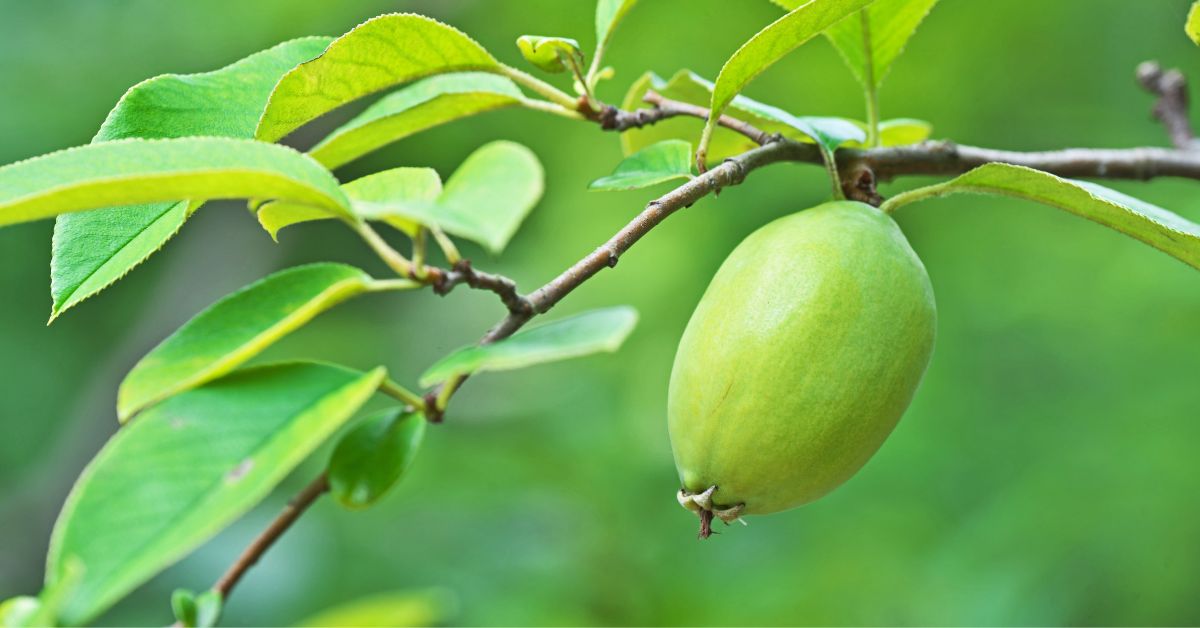
Full sun, with almost any decent soil that isn’t prone to either poor drainage or low moisture. Do not encourage excessive growth by applying fertilizers that are high in nitrogen. The eager shoots that result are particularly prone to fireblight. Instead, use an organic low-nitrogen fertilizer: Organic fertilizers release nutrients more slowly, which helps reduce the formation of fast-growing shoots.
How to grow Chinese Quince? The Basics:
Plant in Spring and, if you have the room, let the tree grow mostly on its own, forming whatever multiple trunks it may. Prune only to remove lower limbs, so that visual and physical access to the developing trunks is easier. Prune in Winter, and prune annually—regularly, in other words—so that large-size cuts can be avoided: They are thought to facilitate entry of the fireblight bacterium.
Another way to handle it
To my eye, the striking fluting is even more exciting when the trunk is vertical. Then the look really is of a column surrounded by rippling floor-length drapery. This means that the tree would be grown with just one trunk, not several.
To achieve that, prune off any lower branches or sprouts right from the ground level, leaving just one vertical stem that, over the years, will become the single columnar trunk. As usual with this species, prune only in Winter, when the risk of fireblight is much less.
Stake the young tree if needed so that its solo trunk is vertical. Be careful to remove the ties and stake as soon as that verticality seems secure so as not to risk binding into the young trunk with the ties and, potentially, putting a cinch mark in the developing flutes.
Trees that are allowed to grow free-range will eventually become too tall for easy or quick spraying to control fireblight. After your tree’s trunk or trunks are head-high, consider pruning back the branches above by half every other year. Flowering and fruiting will probably be more profuse in the intervening year, while the pruning will prevent the overall height and width from becoming too large to spray neatly. It’s probably best to prune half of the branches back (by half) one year and the other half (by half) the next.
Pseudocydonia doesn’t grow quickly enough to reform a canopy of acceptable size if all the branches were cut back each year: This is not a tree to pollard dramatically and uncompromisingly —everything whacked back to nubs each year—that would be the norm for pollarded willows, catalpas, and lindens.
Further, such radical pruning would encourage the growth of just the vigorous soft stems that are more at risk of contracting fireblight. The annual half-by-halves pruning I recommend is more likely to maintain a compact canopy while minimizing the production of such wild new growth. See “Downsides” below for more information on fireblight and how to handle it.
Quirks and special cases
The fruit is highly aromatic and can perfume a room even when sitting uncut in a bowl. Given that the fruits are usually undamaged by falling from the tree, you can usually pick all the Chinese Quince you need by picking them up.
Downsides
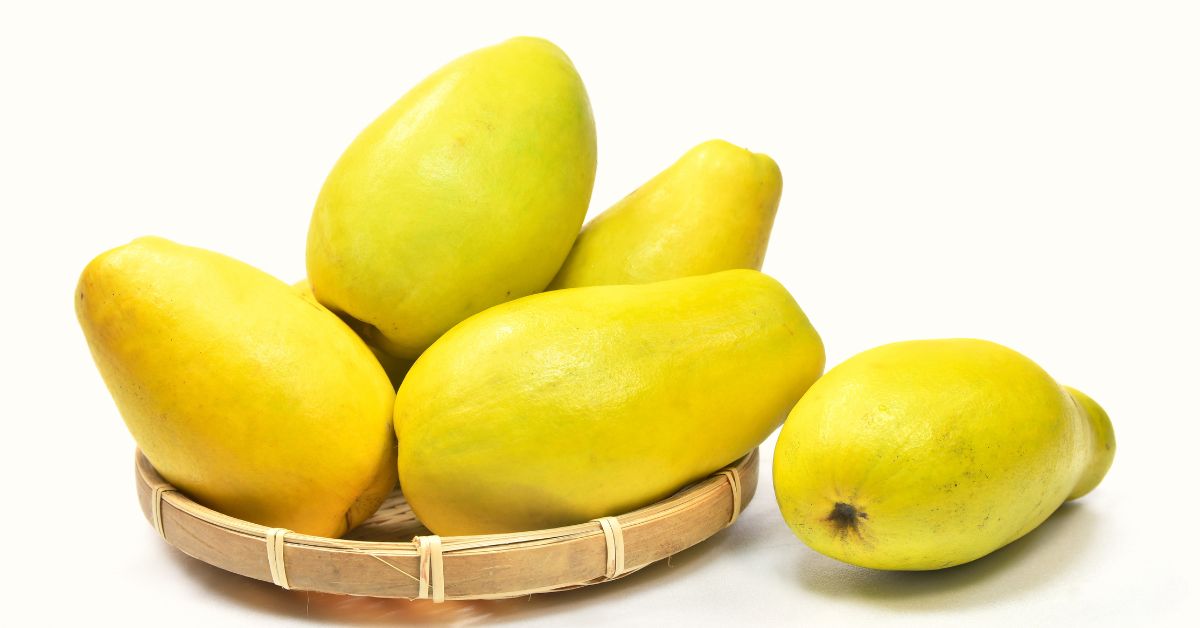
Although the fallen fruits usually don’t squash or make a slippery mess, in the way of those apples or ginkos, they could put visitors at risk of tripping or turning an ankle. See “Where to use it in your garden.”
The species is routinely described as being highly susceptible to fireblight. The inference is that Chinese Quince is always at risk, always liable to be slain by the infection. In contrast, one nursery described the plant as a “hand-me-down” tree was established all over the eastern United States. One way or another, then, long-term survival is possible.
Warm, humid weather, especially at night, puts plants at greater risk of infection. Drier weather and cooler nights reduce risk. In general, fireblight is more frequent the farther south you garden east of the Mississippi.
There might be little or no risk in drier and colder regions west of the Mississippi. Check with the local office of the USDA Cooperative Extention Service to learn whether there is a risk of fireblight where you garden. You may be fortunate to live where there’s little and, so, could grow Pseudocydonia without worry.
Pseudocydonia is one of the few plants for which I would commit to a spray program, plus the attentive but measured annual pruning to control canopy size and make the spraying more practical. Use an organic copper-oil spray each Spring, just as the flowers emerge. If annual spraying is a necessity, you’ll need to site Pseudocydonia far from buildings and either choose companion plants that won’t be harmed by the inevitable drift of spray during the application or shield them with a tarp.
Regardless of even a small risk, it’s wise not to plant Pseudocydonia near other plants of known fireblight susceptibility—which also includes another Chinese quince. Until a resistant cultivar is available (see “Variants” below), grow Pseudocydonia only as a solo specimen.
Chinese Quince Variants
The species’ range of unique and outright thrilling attributes makes the limited availability of cultivars—which, by definition, are notable for even better performance—painful. So many talents, so much possible room for even greater beauty: The flower color can vary from white to pink, but that’s just a matter of a week or two in Spring. Of year-round importance, perhaps the intensity of the pattern of bark exfoliation varies. Also of year-round importance, maybe so does the tendency toward trunkal fluting.
And what about fruit color, taste, size, abundance, and persistence on the branches? (Yes, a red-fruited cultivar is reported—although I can’t locate it—as is ‘Pink Bells’, whose flowers are somewhat rosier.) What about Fall foliage brilliance? And perhaps most critically, what about resistance to fireblight? After all, the performance of a dead tree fails across all metrics.
If a disease-resistant cultivar could be identified, this stunning species would be planted with more confidence and, therefore, more widely. Individuals of distinctive excellence would more readily be noticed, and crossing them with the disease-resistant form could then proceed. What a distant but dazzling future would result.
Not least, I wouldn’t hesitate to plant an entire allee of Chinese Quince, or a circle or even grid of them, not just a solo specimen. Could there be too many fluted trunks in a given garden? No. In one’s life? Not in mine.
Propagating Chinese quince
By seed, although particular attributes would not necessarily be present in the offspring. Individual plants would need to be propagated from cuttings by rooting or grafting.
How to propagate from cuttings?
After removing the bottom leaves, the cuttings should be dipped in water containing a rooting hormone. Be sure to give your cuttings plenty of water after planting them in a mixture of sphagnum peat and perlite. It will be easier for cuttings to take root if they are grown in a greenhouse that is kept at a warm and humid temperature or on top of a seedling heat mat.
How do you divide quince?
Remove all of the leaves from the plant except for the top two, then make a second incision approximately 1/4 inch below a node. Cut out a few of growth points that are about 5 or 6 inches long (where the leaves where that you pulled of) Remove a piece of the bark from this region, then put it in potting soil after it has been dipped in rooting hormone. They ought to develop roots in about a month’s time.
FAQ
Where do you find quince?
Iran, Turkey, and maybe Greece and the Crimean Peninsula are the countries of origin for the quince tree, which is the sole member of the genus Cydonia. The raw fruit is pungent and astringent, but it makes a great preserve and is often used to impart flavor and sharpness to apples that have been baked or stewed. The fruit has a distinct scent.
How long does it take for a quince to grow from seed?
When grown from seeds, quince trees should begin producing fruit in around five years.
If all you want is a gorgeous blooming ornamental tree, then the quince is a great choice since it requires very little maintenance. It may take anywhere from three to five years, depending on the rootstock, for the tree to produce its first fruit, and it may take up to 10 years for the tree to achieve its maximum productivity. When planting fruit trees, people often fail to take time into account.
Are quince trees easy to grow?
As long as you can provide the right environment for their growth, quince trees aren’t all that tough to cultivate. Pick a spot that gets plenty of sun and has rich soil. Quinces are hardy enough to grow in soil that is either wet or dry, but they provide the greatest results in soil that drains well. In addition to that, you will need to plant two trees so that there is sufficient pollination.
How long do quince trees live?
In the months of April and May, they have fragrant blooms that open to reveal a light pink color and have a beautiful appearance. Quince trees have a long lifespan and may continue to produce fruit for as least fifty years after being planted.
Do quince have deep roots?
Yes. Freshly planted bushes have a greater demand for consistent watering. Once it is established, this shrub has a low water need because to the extensive root system it has. It is advisable to water the plant from its base and to prevent getting the leaves wet while you are watering. You should only water the plant in the morning, so that it may have the rest of the day to dry out.
Does quince need full sun?
Yes. Grow blooming quince bushes where there is full exposure to the sun. It is possible for it to grow in partial sunshine, but the plant will produce a more beautiful flower show if it is grown in full sunlight.
How often do you water a flowering quince?
In general, Flowering Quince plants only need a single, substantial watering once every seven days. The amount of time between waterings might vary from place to place and year to year depending on the weather. If you check the soil in the intervals between waterings and find that it is still wet to the touch, you should not water your plant.
What does quince taste like?
The perfume of a golden quince is rich and heavy, with notes of apple, pear, and citrus fruit interwoven throughout the bouquet. When a quince is cooked, its flesh transforms from hard and sour to soft and thick. It also acquires a flavor that is sweet and somewhat spicy, and its fragrance becomes even more intense.
